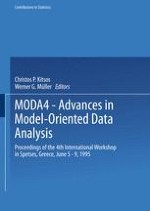This volume is the proceedings of the 4th International Workshop on Model-Oriented Data Analysis. This series of events originated in 1987 at a meeting in Eisenach, that successfully brought together scientists from numerous countries of the 'East ' and 'West'. Now that this distinction is obsolete dialogue has been greatly facilitated, providing opportunities for this dialogue, however, is as vital as ever. The present meeting at Spetses, Greece from 5th to 9th of June 1995 again assembles statisticians from all over the world as this book documents. The hospitality offered by the University of Economics of Athens and the Korgialenios School made it possible to organize this workshop. The editors are also grateful to Intracom (Greece), the Ionian Bank and the Procter & Gamble Company (USA) for their generous support. We would particularly like to mention Dr. Michael Meredith, who being our contact person at Procter & Gamble, enabled us to publish these proceedings. Further thanks go to Dr. Peter Schuster from Physica Verlag Heidelberg for his continuing support of the project. The contributions to this volume were carefully selected from the submissions by the editors after a one stage refereeing process. We would like to thank the members of the MODA committee, A.C. Atkinson, R.D. Cook, V.V. Fedorov, P.Hackl, H. Lauter, B.Torsney, LN. Vuchkov, H.P.Wynn,and A.A. Zhigljavsky, who not only defined the main topics of the workshop, but also served as the referees.
